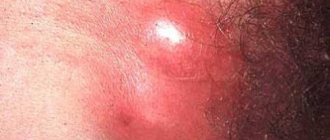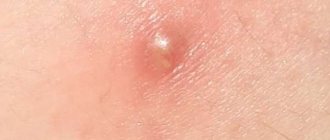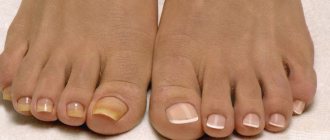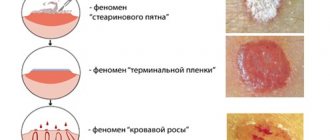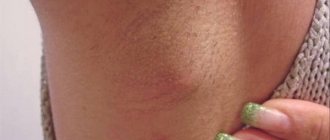When purulent formations form, a large pimple appears on the skin. It does not bring serious consequences for health or life, but discomfort appears that develops into severe pain. The cosmetic defect causes stiffness of movement and suppresses the patient’s psycho-emotional state. Timely treatment is required so that the pathology does not spread and enter the systemic bloodstream.
Ideas about the disease
A boil is a lesion of the epidermis of an infectious-inflammatory nature. It is localized next to the sebaceous gland and neighboring tissues. The pathology is caused by bacteria of opportunistic microflora, which quickly multiply, releasing purulent exudate. For deep formation of a boil, a favorable environment must be present, for example, accumulation of dirt, a large amount of sebum.
Pathogenic bacteria are always concentrated on the skin, but they begin to actively multiply and infect the epidermis only after exposure to unfavorable factors.
For example, if an excessive amount of cosmetics, dirt, and sebum accumulates on the skin. Under these conditions, the balance of opportunistic microflora is disrupted. Bacteria are activated, in response to which a large number of immune complexes are formed. This leads to an inflammatory response that extends all the way to the hair root and adjacent soft tissues. This disease is called furunculosis.
What ointment should be used to treat a purulent abscess with furunculosis in the groin in men and women?
Ointments for furunculosis
If you want to quickly get rid of a purulent abscess that has arisen in the area where the boil appears, then treat this problem comprehensively. If you missed the right moment and a core has already formed under the skin, then taking tablet antibiotics may not be enough. In order for the boil to open as quickly as possible, you will need to stimulate this process with special ointments.
Moreover, you must remember that any purulent abscess is treated in several stages. First, you will need to help the boil ripen, then draw out the pus from it as soon as possible, and after the wound is completely cleansed, do everything to prevent pathogenic bacteria from getting into it again. In view of this, to effectively treat a purulent process, you will need at least three different ointments.
So:
- Pulling ointments. Similar drugs, regardless of price and manufacturer, act on the same principle. Once on the skin, they begin to irritate it, thereby increasing blood flow to the inflamed hair follicle. Against the background of this process, metabolic processes in the dermis increase quite noticeably and this leads to the fact that the abscess first matures and then opens without outside help. In addition, pulling ointments have a weak analgesic effect and slightly reduce itching. Such products are applied under a sterile bandage to a boil treated with antiseptic agents. Medicines with a pulling effect include Vishnevsky ointment, ichthyol, syntomycin and heparin ointment.
- Antibacterial ointments. This type of ointment contains substances that disinfect the wound and kill pathogenic microflora that remains on the skin after using pulling preparations. But remember, if you want antibacterial agents to have the correct effect on the boil, then before using them, be sure to treat the inflamed area with hydrogen peroxide. It will help remove remaining pus and blood from the wound, thereby facilitating faster relief of inflammatory processes. This group includes the following ointments: Oflokain, Fastin, Streptonitol, Levosin Hinifuril.
- Healing ointments. You can start using such remedies only after all the pus has come out of the wound and the redness and swelling have decreased slightly. With proper and regular use, healing ointments will help reduce itching, which almost always appears when an open wound heals, and will also help to enhance regeneration processes in the dermis, which will allow the skin at the site of inflammation to recover as quickly as possible. At the last stage of treatment of a boil, you can use Solcoseryl, Rescuer, Povidone Iodine or Liniment Aloe.
Causes
The following damaging factors leading to purulent formation are identified:
- suppression of the activity of the immune system, as a result of which the number of pathogens is not controlled;
- taking medications - antibiotics, cytostatics, immunosuppressants;
- infectious diseases localized in the reproductive system, sexually transmitted diseases (mycoplasmosis, ureaplasmosis, gonorrhea, genital herpes);
- the influence of low temperatures leading to hypothermia, this factor more often causes furunculosis in the presence of a recurrent form (cooling occurs when using unsuitable clothing in severe frosts, swimming in a cold body of water);
- prolonged lack of quality hygiene;
- pubic lice infestation;
- increased sweating, especially in hot weather, is a favorable environment for an increase in pathogenic microflora;
- hormonal imbalance;
- metabolic disease;
- lack of vitamins, microelements, minerals;
- the formation of small or large skin lesions through which infectious microorganisms quickly penetrate;
- the use of low-quality bedding or underwear, in which the skin does not breathe and actively sweats.
It is important to first identify the cause of the damage so that treatment leads to positive dynamics.
Reasons for appearance
A boil in the groin forms quite often, but most people tend to hide the situation and not consult a doctor, embarrassed by the upcoming examination. Such a neglectful attitude towards one’s body is fundamentally wrong, because the key to quick treatment is to determine the cause of the development of the boil. Without the appropriate skills and knowledge, you will not be able to do this; only a doctor can accurately get ahead of the provoking factor and make a diagnosis.
As a rule, a boil in the groin area can be caused by the following reasons:
- decreased immunity and the body’s inability to independently suppress the causative agent of the inflammatory process;
- uncontrolled use of immunosuppressants and drugs from the group of cytostatics;
- urogenital diseases;
- hypothermia of the body;
- the presence in the perineum of a nutrient medium for the proliferation of pathogenic flora - hemorrhages, microtraumas or dead tissue;
- disturbance of local blood circulation;
- failure to maintain personal hygiene in the intimate area;
- increased sweating;
- hormonal imbalance;
- lack of vitamins;
- pediculosis of the pubis.
One of the most common reasons for the development of boils on the pubis is wearing tight synthetic underwear, which creates friction and injures the skin. Even minimal damage to the epidermis becomes an “entry gate” for infection.
Stages, symptoms of the disease
The table lists each stage of abscess formation and negative symptoms leading to discomfort.
| Stage | Symptoms |
| Infiltrate | The skin turns red, thickens, and swells. A large number of immune complexes are released that develop an inflammatory response. Up to 3 cm of infiltrate can accumulate inside. The skin thickens and enlarges, causing severe pain. The hair follicle and the hair itself are preserved in the center of the formation. An area of inflammation remains inside the follicle, causing burning and tingling |
| Purulent-necrotic area | Forms by 4 days after the onset of the pathological process. The purulent formation is actively maturing and a core is forming. The head increases in size, so it rises above the surface of the skin. The pain syndrome becomes brighter and intensifies with pressure, walking, and other movements. There is strong pulsation, a rise in body temperature, and an increase in regional lymph nodes. Due to intoxication, arthralgia and myalgia appear. Lymphocytes, pus, and abundant bacteria accumulate inside the formation. The skin bursts, the infiltrate comes out. |
| Regeneration | When the purulent contents come out along with the rod, all discomfort and symptoms stop. Pain, itching, redness are eliminated. If the opening occurs spontaneously, the liquid gradually comes out. A large wound is formed that will heal within 3 days. Then she turns pale. Thanks to active tissue regeneration, the skin actively heals. But a large connective tissue scar may form at the site of the wound. |
If the doctor eliminates the boil, the removal of the rod is required. Otherwise, the bacteria in it will multiply again, causing another purulent infiltrate.
When should you see a doctor?
It is best to contact a dermatologist at an early stage, when you have just noticed inflammation of the hair follicle; it is at this stage that the doctor can take appropriate measures and prevent the formation of a purulent infiltrate inside, killing the pathogen.
If you notice a pathological process, already at the stage of boil formation, do not try to treat yourself or pierce the tubercle with a needle, you will only worsen your condition. It is imperative to consult a doctor if there is a temperature above 38 degrees and general intoxication of the body is noted. You should not hesitate to visit a dermatologist if redness appears in other areas of the skin, and the boil itself does not open for a long time.
There are a number of situations in which the skin becomes inflamed in several places at the same time, and boils merge with each other into an extensive infiltrate with purulent contents. This condition is very dangerous and must be operated on in a hospital setting.
Therapy methods
The selection of treatment depends on the stage at which the boil is developing. Home therapy is usually sufficient. If complications occur, hospitalization will be required. For example, if the abscess has reached the subcutaneous fat or systemic blood flow, a large abscess has formed.
Most often, local therapy is prescribed; in the absence of its effect, surgical techniques are prescribed:
- Treatment with antiseptics
. Salicylic alcohol, hydrogen peroxide, and other antiseptic drugs are prescribed. They treat tissues using cotton wool to prevent the spread of infection. The hair in the affected area is cut off. - Anti-inflammatory therapy
. To eliminate excessive activity of the immune system, the application of alcohol compresses is required. Additionally, Chlorhexidine and Miramistin are used for disinfection. Compresses can be used with Levomekol, Ichthyol. They relieve inflammation, pain, and destroy infection. A keratoplasty effect develops. To make a compress, first apply ointment to the affected area. Apply cotton wool or several layers of bandage on top. Leave for several hours, then remove. Physiotherapeutic procedures have a qualitative anti-inflammatory effect. For example, the use of ultraviolet or laser. - Second stage therapy
. It is necessary to create all the conditions so that the boil matures faster and prepares for spontaneous opening. Pre-treat the affected area with ointments that cause ripening. For example, Vishnevsky, Ichthyolova. An antibiotic ointment is then prescribed to reduce the number of pathogenic microorganisms. The abscess is opened through surgery and all contents are removed. - Injections of antibiotic and novocaine
. This helps to simultaneously eliminate pain and reduce infection. The doctor prescribes injections until the core of the boil is completely eliminated. Compresses based on silver nitrate have a similar effect. - Systemic antibiotics
. Used as injections or oral tablets. Penicillins, macrolides, cephalosparins are prescribed. Additionally, NSAIDs are used to relieve pain, inflammation, and relieve elevated body temperature. Use drugs based on paracetamol or ibuprofen. - Surgical extraction
. Pre-treatment with salicylic acid is carried out. It helps the skin burst so that the contents of the abscess begin to come out. The rod is removed using a clamp. A rubber band is left inside for 3 days to allow further drainage of pus. After time has passed, it is removed. Surgical methods can be resorted to only if there is no effect from conservative techniques. - Sanitation
. The technique is applicable after opening and complete elimination of the abscess. They are treated with antiseptics and antibiotics. For example, hydrogen peroxide is used, thanks to which the remains of lymph and pus are eliminated. After the healing stage has begun, it is allowed to use Vishnevsky ointment in the form of a compress for another 3 days. Ichtheol ointment is not recommended at this stage, since the bacterial infection will be difficult to eliminate.
If the treatment is not of sufficient quality, there will be a risk of relapse. Therefore, it is necessary to pay close attention to all stages of processing.
When treatment is carried out, all hygiene rules must be carefully observed. Additionally, it is prohibited to visit baths, saunas, and gyms. As soon as the wound healing stage has begun, Contractubex is allowed to be used. It prevents the formation of a large connective tissue scar.
Video ideology and stages of furunculosis
Furuncle during pregnancy
During pregnancy, etiological factors are identified, as in the normal state. But a woman’s immunity during this period is unstable, so any provoking factor can lead to the formation of an abscess. Also, the following changes are formed in her body, placing her at risk for the development of furunculosis:
- hormone imbalance;
- immunosuppression;
- slowing down metabolism.
If an abscess forms in the groin area, it becomes dangerous not only for the woman, but also for the fetus, since bacterial microorganisms can penetrate the systemic bloodstream. From there they spread through the placenta into the amniotic fluid and the fetal body. Therefore, at the first symptoms of the development of a boil, you need to immediately consult a doctor to exclude complications.
The following recommendations for therapy are distinguished:
- a ban on the use of systemic antibacterial drugs, most of them have a negative effect on the fetus;
- local anesthetics in the form of Miramistin, Chlorhexidine, Furacilin are allowed;
- local ointments are applicable - Ichthyol, Vishnevsky, Levomekol.
Surgical therapy is rarely performed during this period, only if there is a risk of serious complications.
Possible consequences if left untreated
A boil in the groin area must be treated, otherwise you may face serious consequences. The fact is that the groin area is in close proximity to many blood vessels, and when Staphylococcus aureus or another microorganism enters the general bloodstream, it can provoke sepsis, which ends in death. A boil in the groin that is left without proper treatment can cause lymphadenitis. Regional lymph nodes are located in the groin area and the inflammatory process can spread to them, turning into lymphangitis.
A furuncle on the pubic part in women is fraught with inflammation of the uterus and its appendages, since purulent infiltrates can cause some “metastases” to nearby organs. If you do not start therapy in a timely manner, you may experience infertility.
Most women and men are very embarrassed when they discover boils in the intimate area, and accordingly are ashamed to go to the doctor, start the disease and seek help when the situation cannot be normalized. If you notice inflammation in your pubic area, do not waste time on self-medication; the sooner you seek help, the sooner you will return to your previous life. There is nothing shameful in wanting to be healthy; it is much worse to endure the symptoms of furunculosis and do nothing.
Complications
Complications occur only if conservative methods of therapy are not carried out in a timely manner. If there is no antiseptic or disinfectant treatment, the following deviations are formed:
- lymphadenitis
- active inflammatory processes in the lymph nodes, when severe intoxication of the body occurs; - lymphangitis
- movement of the inflammatory process to the area of lymphatic vessels; - recurrence of purulent infection, transition to a chronic process
- the persistence of the aggressive influence of pathogenic microflora due to insufficient treatment, leading to the accumulation of subcutaneous pus, obstruction of lymph flow and other complications; - sepsis
is a bacterial infection of the blood when pathogenic microorganisms pass from an abscess into the bloodstream; - arthritis
— excessive activation of the immune system with the additional formation of an inflammatory process in the joints; - pyelonephritis, hepatitis
, which formed as a result of the transfer of infection from the boil to the internal organs; - widespread furunculosis
- periodic occurrence of boils in the groin and other areas of the body due to aggressive pathogenic microflora spreading throughout the epidermis; - abscess
- the transition of a purulent core down to the subcutaneous fat with the formation of a capsule, inside which contains a large amount of pathogenic microflora along with pus.
If the patient tries to squeeze out the boil on his own, many complications will arise. The plug may be opened too early or incorrectly, causing damage to adjacent tissue. The pus will pass into the blood and lymphatic vessels, causing infection of the blood and internal organs. This condition is dangerous not only for the affected area, but also for the entire body. May be fatal.
In many women, the formation of a purulent infection in the groin begins after depilation of the intimate area. There is slight damage to the epidermis, through which pathogenic microorganisms actively penetrate. Therefore, you need to be careful with the procedure.
Furuncle, boil in the groin in men and women: symptoms, causes, photos
Initial stage of furunculosis
Ripe boil
Opening a boil
Scientists have found that the most common cause of a boil is the staphylococcus bacterium. Once on the skin, it almost immediately begins to inflame the hair follicle, thereby provoking the development of a purulent process.
Therefore, if you notice that abscesses appear in your groin with enviable regularity, then be sure to get tested and find out if you have become infected with staphylococcus. If this is the case, then you will need to fight both the pathological bacterium and the furunculosis that it provokes.
Other causes of boils in the groin in men and women:
- Poor immunity . If the body's defenses are at zero, then even the slightest injury to the skin in the groin area can lead to inflammation of the hair follicle and sebaceous glands.
- Poor nutrition. Due to the fact that the internal organs do not receive the substances they need, the body works for wear and tear. And this leads to the fact that a person’s defenses are catastrophically reduced, and as a result, various inflammatory processes are activated.
- Untimely implementation of hygiene procedures. If a man or woman does not wash their genitals every day, sooner or later this will lead to the formation of boils in the groin area. This will happen due to a banal blockage of the sebaceous glands.
- Uncomfortable underwear. Tight or simply too small panties can seriously injure the skin in the groin. From constant friction, cracks will appear on it, into which pathogenic bacteria can enter and this will also lead to the appearance of boils.
- Excessive sweating. In this case, a so-called greenhouse effect is created under the underwear, which contributes to clogging of the pores and inflammation of the hair follicle.
- Hypothermia. If a person freezes for days on end (sits in a draft, washes with cold water, or simply dresses poorly), then this greatly affects his immunity and, as a result, he no longer has the resources to fight furunculosis.
- Shaving . Incorrect or careless shaving of the groin area can lead to the appearance of wounds, which can subsequently become infected with the same staphylococcus or other pathogenic bacteria.
Symptoms of a boil in the groin
Symptoms of a boil in the groin:
- At the first stage, you may feel only slight discomfort in the area where the boil will subsequently appear. A noticeable change in the color of the skin can complete the picture.
- After some time, the pain begins to intensify, and a hard-to-touch seal appears inside the red spot. At this stage of the disease, quite severe itching and noticeable tingling in the area of inflammation may appear.
- At the next stage, blood, lymph and pus begin to accumulate under the skin. All this leads to the fact that the pain intensifies, the compaction increases in size and the so-called white head appears. If furunculosis is very acute, then fever may be added to all the symptoms described above.
- After the boil breaks out, blood, pus and rodents come out of it. If you carried out the correct treatment, then after the follicle is cleared of all excess, only a crater-shaped pit with slightly inflamed edges will remain on the skin. As it heals, the soreness of the skin will also go away.
Prevention methods
You can always use certain measures to reduce the risk of bacterial infection accumulating on the skin and penetrating into the deeper layers. To do this, use the following rules:
- for excessive sweating, use talc and powders that remove moisture from the epidermis;
- daily use of hygiene procedures;
- consumption of high-quality foods and multivitamins that supply the body with the maximum amount of nutrients;
- strengthening the immune system, hardening procedures;
- elimination of situations leading to hypothermia;
- proper treatment of skin wounds to prevent infection.
If redness and thickening of the skin begins on the patient’s body, it is necessary to carefully monitor this area. If symptoms of furunculosis appear, it is recommended to promptly consult a therapist who will prescribe treatment methods. It is important to start antiseptic and antibacterial therapy in a timely manner so that the infectious area decreases. If treatment methods are carried out in a timely manner, the lesion can be completely eliminated within 7-10 days. This will help eliminate the risk of complications and the need for surgical intervention.
Prevention of furunculosis
Prevention of furunculosis
- If you do not want boils to appear on your body ever again, then even after they disappear, try to take measures that will help you avoid the reoccurrence of this problem. First of all, take care of your immunity. Try to ensure that your body receives the maximum amount of nutrients it needs all year round. To do this, eat plenty of vegetables and fruits every day. In addition, review your daily routine.
- Try to go to bed not too late and get at least 8 hours of rest. Even such simple measures will ensure that the body’s defenses will be at a high level and can easily fight all pathological processes occurring in the body. And, of course, do not forget about everyday hygiene of the intimate area. Daily washing will ensure that pathogenic bacteria, which most often cause the development of furunculosis, will not linger on the skin.
- In addition, try to depilate the groin area as correctly as possible. Before you start removing hairs, be sure to wash your skin with soap and treat with any antiseptic. After you complete the depilation procedure, repeat all the manipulations again.


